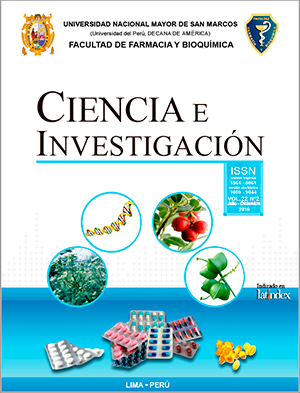In vitro evaluation of the anthelmintic potential of the Plantago major and Carica papaya seeds extracts using C. elegans as experimental model
DOI:
https://doi.org/10.15381/ci.v22i2.17610Keywords:
Caenorhabditis elegans, bioindicator, anthelmintics, Carica papaya, Plantago majorAbstract
In this work the anthelmintic potential of the aqueous and hydroalcoholic extracts of two plants used in traditional medicine as antiparasitic, Carica papaya and Plantago major, commonly known as papaya and plantain, respectively, was evaluated. The results obtained showed that the extracts of both plants possess anthelmintic activity causing mortality of C. elegans, in different concentrations. Based on the determination of LC50, the hydroalcoholic extract of P. major leaves (2,663 mg / ml) induced a mortality 40.5% higher than that of the aqueous extract (4,420 mg / ml); whereas in C. papaya the aqueous extract (2,012 mg / ml) caused a mortality 40% higher than the hydroalcoholic extract (3,350 mg / ml). The results are discussed based on the anthelmintic potential of each extract.
Downloads
Published
Issue
Section
License
Copyright (c) 2020 Erick M. García M., Victor H. González C., Gino C. Atariguana E., Thayana del C. Núñez Q., Fredis F. Pesántez, Katherine González

This work is licensed under a Creative Commons Attribution-NonCommercial-ShareAlike 4.0 International License.
LOS AUTORES RETIENEN SUS DERECHOS:
- Los autores retienen sus derechos de marca y patente, y tambien sobre cualquier proceso o procedimiento descrito en el artículo.
- Los autores retienen el derecho de compartir, copiar, distribuir, ejecutar y comunicar públicamente el articulo publicado en la Revista Ciencia e Investigación (por ejemplo, colocarlo en un repositorio institucional o publicarlo en un libro), con un reconocimiento de su publicación inicial en la Revista Ciencia e Investigación.
- Los autores retienen el derecho a hacer una posterior publicación de su trabajo, de utilizar el artículo o cualquier parte de aquel (por ejemplo: una compilación de sus trabajos, notas para conferencias, tesis, o para un libro), siempre que indiquen la fuente de publicación (autores del trabajo, revista, volumen, numero y fecha).













